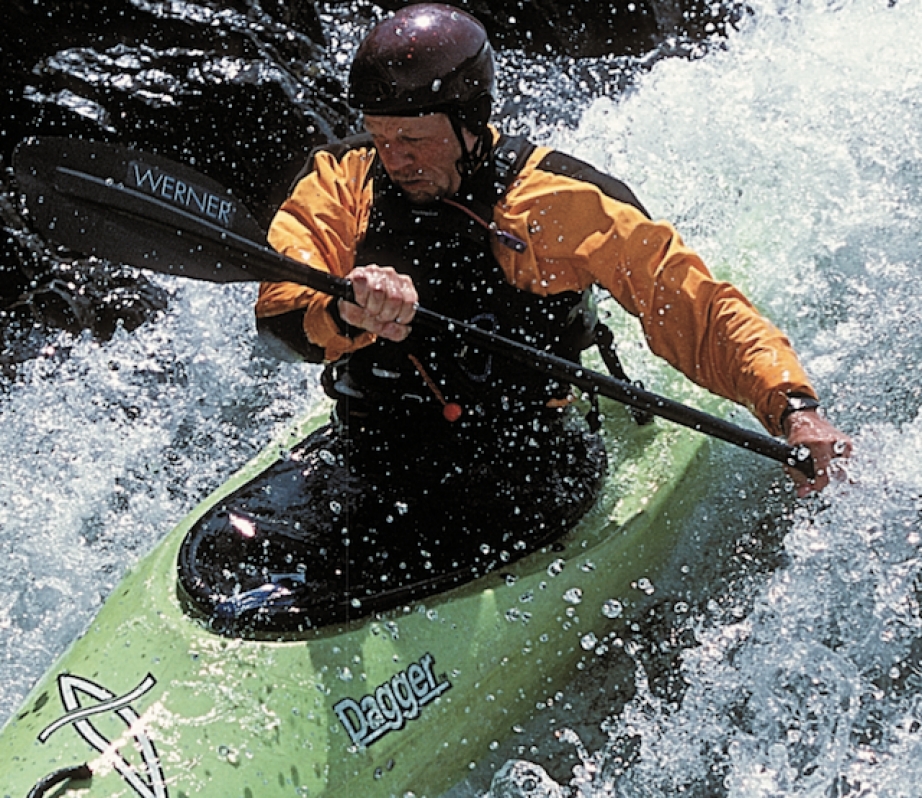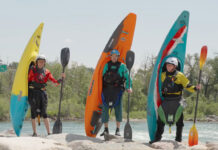Ask any extreme paddler what constitutes a “smaller drop” and you’ll get as many questions as answers. Smaller is a relative term of course, but most paddlers would probably agree that nine small drops out of 10 are done with a boof. Learn more about kayak boofing techniques below.
Definition: What is boofing?
Boofing is that “pull from the bow, knee lift, acceleration” move that lifts you clean off the lip of a drop and prevents your bow from diving on landing. Even in the best conditions, you need to choose the right boof and pay attention to the bow–stern trajectory of the boat, as landing dead flat, even off smaller drops, is a real shock.
Why boof?
Most of the time, inadvertent pencilling off small drops works out—but when it doesn’t, the results can be crushing. If there’s something lurking down below or when you are unsure what is down below, keep the bow up on the surface.
Small drops and pourovers with sticky recirculations are good places to boof. You can land on the boil, skip off, and ricochet clean of the drop. This is great for tighter recirculations, or when you have a must-make move immediately downstream. A clean boof means you are more likely to land in control and on line for the next move.
Basic Boofing: 3 Easy Steps
The boof can be broken down into 3 key steps: cross-current speed, stroke timing, and edge transfer. Many intermediate paddlers think the boof is just a big vertical stroke. This is a bit of a misconception and we have found this teaching progression is a great way to learn how to boof.
Cross-current speed
Having cross current speed gives you the proper set-up for the boof. It is important to dial in, controlling your cross-current speed on basic eddy lines before moving on.
Stroke timing
When enough cross-current speed has been generated, you will typically take the boof stroke on the downstream side. With enough cross-current speed, you can plant the blade in the water as you are nearing the eddy line. As the paddle blade approaches the eddy line, you can pull on a vertical power stroke and try to pull your hips past the eddy line.
Edge transfer
As you are nearing the eddy line, lift your upstream edge as you prepare to take your boof stroke. As you land the boof, transfer your edge, which allows you to accelerate past the feature you just boofed over.
Breakdown of Kayak Boofing Techniques
Sweep-and-Leap Boof
On small drops with a smooth green lip, a well-timed sweep and pull stroke can lift the boat clear of the water and allow for a controlled launch. Approach the drop slowly, so you are in control and the boat is loose on the water rather than embedded in the flow or caught in its own wave. The bow should be somewhat off of perpendicular to the recirculation below—say 30–45 degrees or so.
As the bow reaches the lip, sweep the bow downstream and up, into the air, off your stern upstream edge. When the boat extends out over the drop, thrust your hips forward, transition to the opposite edge, and throw your upper body forward to help the stern clear the falling water.
You land on an outstretched power stroke on the side opposite to the initiation sweep. On bigger drops you’ll need less sweep, or more angle to the drop, because you are falling further and the boat has more time to spin. Brandon Knapp is the airborne master of sweep-and-leap boofing and often floats off the lip, timing the sweep and pull and landing at an angle to shoot clear off of a crosscurrent or boil.
Power Boof
Sometimes, in desperate or extreme situations, there is no substitute for a power (or even more power) boof. You can execute power boofs on almost all drops. Powerful strokes, good strength and a light boat make power boofing easier.
The concept is to pull with a lifting power stroke so the bow rises as you fall. To be smooth, start with some forward lean, rotate the upper body with a long reach to the bow for a forward stroke, then wait until the boat starts to drop. With your paddle reached over the lip of the drop into the curtain of falling water, pull and lift with your knees. Keep your power stroke close to the boat and don’t lean too far back—pull with the upper body more or less neutral, heaving the boat forward as it teeters off the lip.
Trajectory Boof
Whenever possible, skip or ramp off existing features to assist with your boof. Use pillows on the edge of a drop, folds at the lip, edges of boulders or protruding ledges, even the tops of waves. All of these offer some object to start the bow moving upwards.
Generally, speed is an asset for trajectory boofs, and charging the object means you carry more speed and generate more lift. The ability to hit your line is critical; missing the object or failing to generate lift mean you launch at speed into the drop, with little chance of timing a leap or power stroke. When a trajectory boof is done well, you lean back a little to launch, sit up in midair, and bounce high as the hull rebounds. Warranty departments wince at this maneuver.
Body Position
While many paddlers initiate boofs leaning back in their boats, it is better to stay relatively neutral or even throw your body forward when the boat is airborne to keep the bow down a little while you drop. This forward thrust generates additional forward momentum while in the air.
Double-pumping (two consecutive strokes on the same side) allows your arms to generate momentum after the launch. Tao Berman is the master of this move, and often generates that extra bit of forward momentum while in the air by stroking on one side to boof, then air stroking on the same side. This also helps with balance and avoids the dreaded barrel roll to the offside that can occur on bigger drops where you’re falling a long way.
Practice makes perfect
Timing is critical when running small drops, and practice is important to having a reliable kayak boofing technique. When on the river, utilize every possible object or drop to learn to launch the bow high and land clean.

Try out these kayak boofing techniques for yourself
Thanks for checking out our guide to boofing. We hope it is useful and helps to get you looping at your local play hole and beyond. If you have any further questions, please don’t hesitate to contact us at [email protected].
This article was first published in the Summer 2003 issue of Rapid Magazine. Subscribe to Paddling Magazine’s print and digital editions, or browse the archives.
For more great instructional videos, check out our YouTube channel at www.youtube.com/aquabaticscalgary or our website at www.aquabaticscalgary.com.








